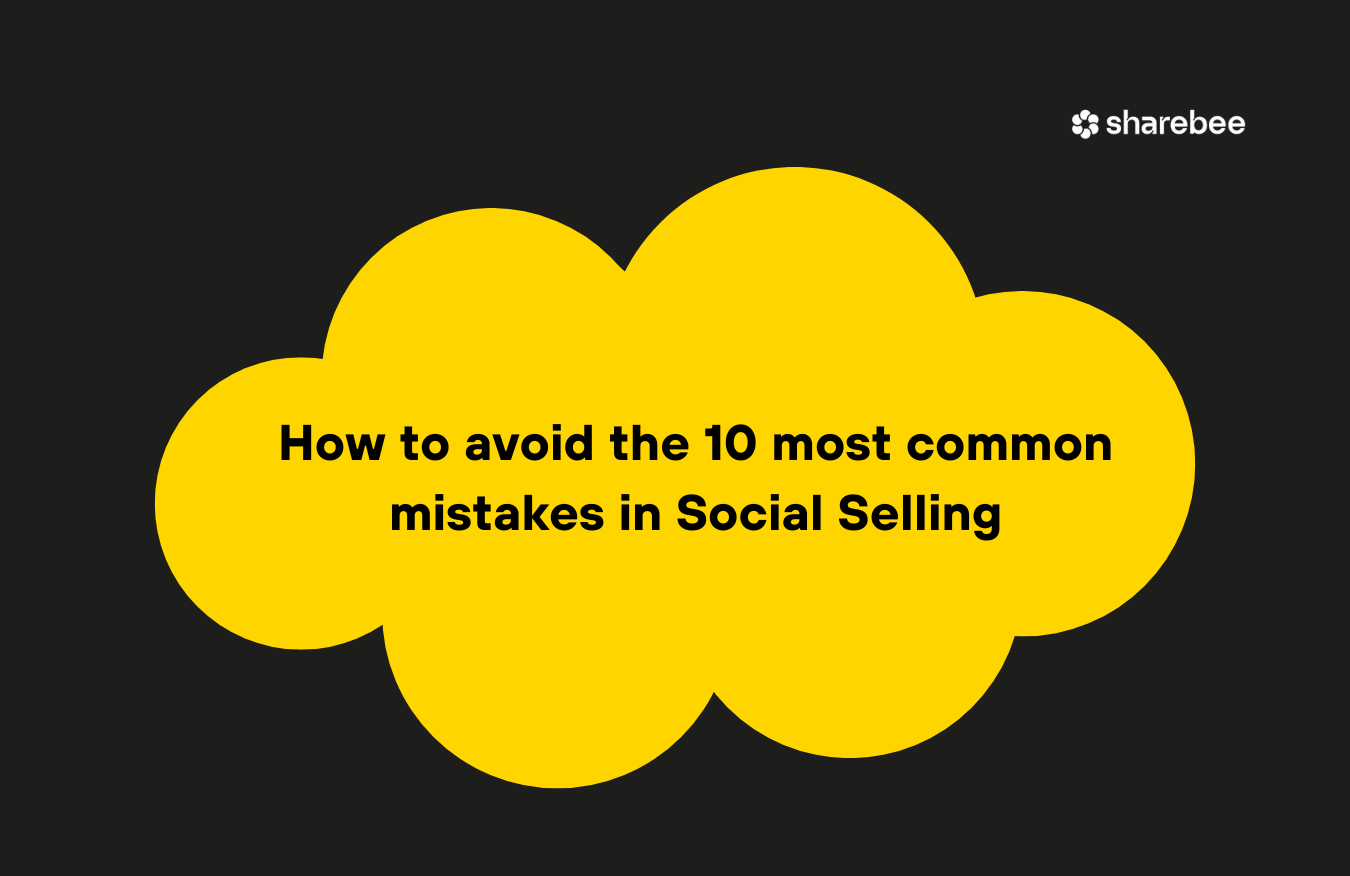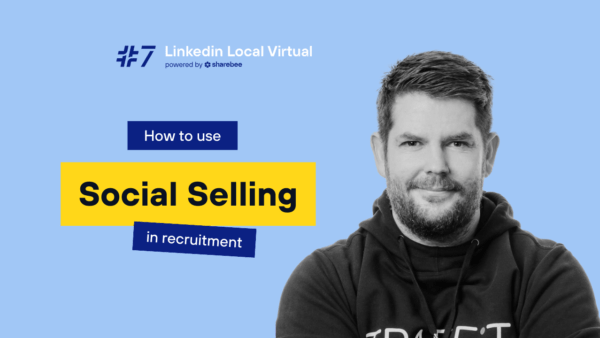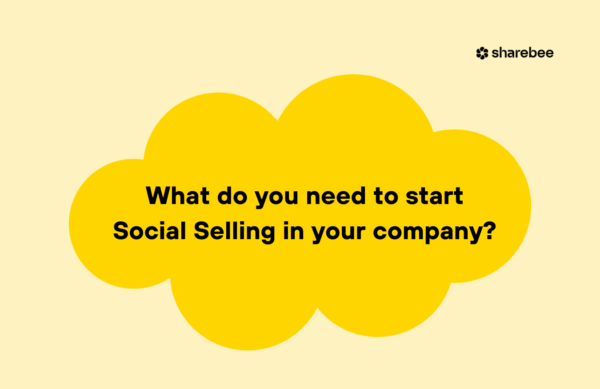Ho to avoid the 10 most common mistakes in Social Selling

Social Selling is a term that is now used in every possible context. Some are acquiring customers using social media, others argue that it doesn’t work. What are the most common mistakes made by salespeople and companies? We provide tips on how to avoid them.
Social media has become another tool for salespeople – like email or even the telephone before it. There’s a lot of talk today about engagement and sales through social media, and Social Selling itself has quickly gained the status of a rising star in sales and marketing trends.
Perhaps someone in your organization also suggested engaging employees on LinkedIn, but you quickly realized that it doesn’t work. Don’t worry, you are not the first such company. Implementing Social Selling programs in companies from various industries, we’ve noticed that many mistakes are repeated.
So how do you implement a Social Selling program in your organization to bring specific benefits? Below we present the 10 most common mistakes of salespeople and companies and suggest how to solve or avoid them in new projects.
The 10 most common mistakes when introducing Social Selling
Lack of understanding of what Social Selling is
Many sellers are still confused by this term. Moreover, not only salespeople, but also people working in marketing, claim that it is about finding customers through, for example, LinkedIn, and then sending offers or posting product advertisements. Social Selling is not limited to these two actions. Social media should help build business relationships through a virtual channel.
This “relationship building” should take place using several important and planned elements.
Social Selling is the process of implementing a long-term strategy, not just immediate, one-off “catching customers” actions by salespeople.
It is also a task for the marketing department to help create content that catches the target group’s attention. Well-prepared posts, graphics, videos, etc., are supposed to arouse potential customers’ interest in us, our company, and build a desire to stay in touch with us. These are virtual relationships that can transition into the real world.
“Social media is for fun”
Unfortunately, there is still a strong belief among some sellers that social media is only about posting worthless or funny posts, spying on friends or just a tool for job searching. Many salespeople are afraid to take social media seriously.
These fears also concern rebuilding personal profile, publishing substantive content, dedicating several minutes a day to professional work on social media channels because others may accuse them of so-called “wasting” time. Nothing could be more wrong, let’s follow the opportunities that, for example, LinkedIn gives us; otherwise, we will remain in the “cold calling” era with meager results.
Your LinkedIn profile does not look professional
Personal brand – what is that? Building a personal brand is also a complex process that won’t happen in 5 minutes. It’s also not a slogan attributed to celebrities or famous people. Each of us can build a personal brand in our environment. A strong, professional brand is essential in the Social Selling process.
Your personal LinkedIn profile is the basis and business card of this brand. If your profile is just focused on your own sales achievements and praising yourself, then surely it’s not the way to go.
Create a profile with the customer in mind and remember to include content meaningful for your audience and target group. Before you start posting anything, think about who will read it, what interests them and why they should spend their time on it? Think today about what you should change in your profile and start rebuilding, even if it’s small steps.
Strong focus on sales
The only thing you do on LinkedIn is post advertisements about your products? Sending 20-30 invitations to new people without a personalized message? Or maybe you bought a premium package and overwhelm others with your long offers? Be careful with such actions, as you may achieve the opposite effect than intended. Instead of forcibly selling something, think about whether you reach the interested audience? Do you want to turn LinkedIn into another “buy-sell” portal?
In the Social Selling process, building relationships is very important, it should happen naturally, not forced. Engage in the content of others, take the time to write substantive content. Recommend valuable materials.
Incorrect target group and too few contacts
One of the mistakes that often repeats when implementing Social Selling is the lack of a defined target group.
- Who do you want to reach?
- Who do you want to interest?
- Do you have buyer personas described in your company?
- And if not, do you know who you want to reach in the B2B purchase process?
- Can you find the right contacts?
- Can you send invitations and expand your contact network?
Get rid of fears of sending invitations to “strangers”. If you want to reach as wide an audience as possible, you need to have a sufficient number of contacts on LinkedIn. For example, if your contact network is only 30 or 40 people, your content will have too small an audience. Learn to write personalized invitations and gradually enlarge your network. Start with what you already have, e.g., contacts in the CRM or contacts from stored business cards.
Uninteresting content
Are you still sharing posts from your company page on LinkedIn, or perhaps you’re posting at inappropriate times? Remember that every social media platform operates on the basis of a certain algorithm. It’s worth understanding technical aspects like whether it’s worth publishing posts at 11:00 pm on a Sunday. Avoid duplicating content and don’t pull posts from your competitors. Try to diversify your posts in terms of graphics.
Remember that one of the most liked types of content are so-called advisory content. Try to publish regularly.
If your company is engaged in Social Selling activities, it’s worth thinking about planning texts and placing them in a free content calendar or through an Employee Advocacy tool like Sharebee
Neglecting contact search
Some salespeople think that building a network of contacts happens by itself. However, a profile on LinkedIn alone will not make customers find us.
It’s important to also spend time on prospecting activities yourself. Various types of excuses often appear: “it doesn’t work”. Searching for contacts from the target group is an important aspect, but you need to know how to do it to achieve real results.
Lack of employee engagement
This is often related to the lack of preparation and implementation of a comprehensive Employee Advocacy plan. Employees often treat social media without much conviction. Lack of a clear direction for the company’s operations, a developed strategy, presentation of benefits, and inconsistent activities can increase employee concerns and treating the Social Selling program as a new “invention” in the company.
Lack of clear goals
In reality, many companies do not have a strategy for social media activities. This channel is most often used in personal activities. Such an approach may lead sales representatives to use social media without any clear goals or overarching strategy.
If the company has not set measurable goals, it will not be possible to check whether we have achieved success, nor to recognize areas that need improvement.
Unfortunately, this approach is very common. Lack of direction in which the company is heading introduces confusion among employees, which can ultimately lead to a lack of belief that the Social Selling program is effective.
Incorrect analysis
Employees and companies often hear: “You must be on social media, regularly publish posts and build a network of contacts”. However, if the activities are not analyzed and we do not know what to measure, it will be difficult to draw conclusions whether Social Selling works.
It’s worth analyzing activities such as the number of potential customers acquired this way, the number of generated phone calls or personal meetings, the number of views of posts and/or shared content, the number of visits to the website, and even the Social Selling Index.
Remember, we all make mistakes and fall into bad habits – especially when it comes to the initial phase of implementing Social Selling activities in the company. So if you don’t see results, make sure that your company and you are not making the mistakes listed in this article. Treat social media as new opportunities to reach potential customers. Try to avoid the above shortcomings and improve your social media skills every day.







